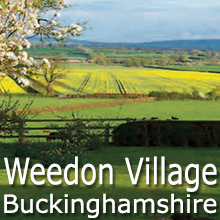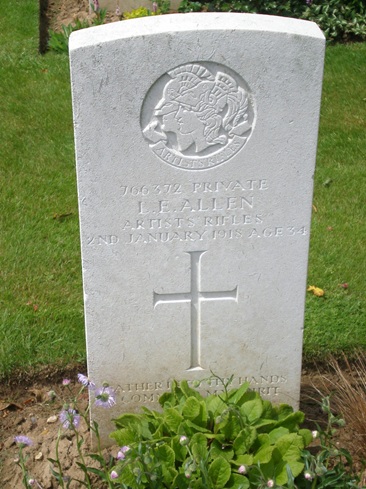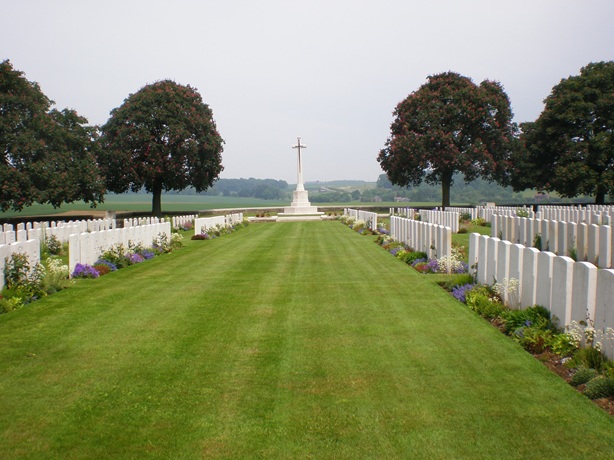THE FORGOTTEN FALLEN
|
|
LIONEL EDWARD ALLEN Private 766372 1st/28th Battalion, London Regiment (Artists’ Rifles)
Died of Wounds aged 34 2nd January 1918
Buried Rocquigny-Equancourt Road British Cemetery Manancourt, Somme, France
|
|
Lionel Edward Allen was born in the spring of 1883 with the birth registered in Louth. The 1891 census shows him living in the Vicarage in Romford, Essex, the son of Francis and Rose Allen, the youngest of nine, with five older sisters and three older brothers. He was born in Binbrooke in Lincolnshire, although his brothers and sisters were born elsewhere in Somerset and Dorset. The 1901 census shows him visiting the Wright family in The Lodge, South Street, Romford, where Alfred Wright was a Surgeon and Lionel is shown as a Clerk at the Bank of England. By 1911, although still single, he has his own residence in Luton Road, Harpenden and is still with the Bank. When he enlisted in July 1917, at the Central London Recruiting Depot in Whitehall, he gave as his address 18 Vincent Square, London. His parents moved to Hardwick in 1904 where Francis, his father, was Rector of St Mary’s Parish Church. His death was reported in the Bucks Herald. ------ Bucks Herald Report January 1918 HARDWICKE & WEEDON A LOCAL HERO The death of Lionel Edward Allen in a Casualty Clearing Station in France, from wounds received in action, came as a great shock to the inhabitants of the village, of which his father had been the beloved Rector for 13 years. Mr Allen, previous to the war, and up to the time of his joining up, had been on the staff of the Bank of England, where he had gained the esteem and confidence of the heads of the Bank through his thoroughness and devotion to duty. As an illustration of this, he was last winter sent by the Bank to New York on important business. He had from the first the desire to take his share in the great war, but the great business pressure at the Bank, due not only to shortage of staff but also to the heavy work entailed by successive war loans, kept him at his post. When the pressure somewhat relaxed the Bank at his request released him. He joined the 1st Artists' Rifles as a private, preferring to go through the ranks, and went to training at Romford, where his father was Rector before going to Hardwicke. After completing his training, he went to France. He could have been there barely two months when his Battalion went into action. On December 30th, the Germans had secured a foothold in their trenches, whereupon two Companies, of which was Lionel Allen’s, who were holding the counterattack area, were detailed to advance over the open and push out the enemy. In this action he was wounded and died in the Casualty Clearing Station on January 2nd. Captain Pike, who was in command of his Company, stated, ‘I was never prouder in my life than when we went over. The absolute bravery of the men was splendid. There was no hesitation whatever, and the company excelled itself’. In this action the Battalion lost 100 men. All the officers were casualties. Thus, has passed away another of England’s promising lives. He spurned to stay at home but took his life in his hands to help save his country in the hour of her distress. ------
Manancourt lies between the towns of Peronne and Bapaume in Northern France, east of Thiepval where the British Memorial stands; another site in farming land well outside the local village. An imposing stone archway leads to a walled site with a central pathway leading to the Cross of Remembrance. The area was captured from the Germans in April 1917, lost in March 1918 and retaken five months later. The cemetery was started in 1917, later used by the Germans for British burials and finally by British troops until the end of the war. It contains the graves of 1,767 British, 82 Commonwealth, 10 French and 198 German soldiers, sailors and airmen. Many other members of the Artists' Rifles lie buried here. The Artists' Rifles were founded in 1859 amid fears of invasion from France. Edward Stirling formed a volunteer group of painters, sculptors, musicians, architects, engravers and actors from the London artistic community. They bought their own uniforms, and the cap badge was the head of Mars, the Roman God of War and Minerva, goddess of wisdom and arts. During the Great War, the Artists' won 8 VCs, 822 MCs and many other decorations. In 1941, David Sterling of the Scots Guards drew up plans for a hand-picked unit to wreak havoc behind enemy lines. The unit was called the 1st Special Air Services Brigade. After World War Two, the regiment sought a role in the regular army and a marriage of convenience was arranged to incorporate the Artists' Rifles, thus giving rise to the SAS as it is known today. Their magazine is still known as ‘Mars and Minerva’. |
|
GO TO Forgotten Fallen list for more biographies of the men commemorated on the Weedon War Memorial.






